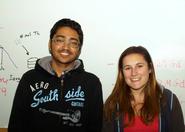
According to The Wall Street Journal’s “Market Watch,” alternative energy is one of the fastest growing industries in the United States. Elizabeth Jonathan ’13, a physics concentrator and mathematics minor, and Sunrose Shrethsa ’14, a physics and mathematics double concentrator, are using their summer research grant to investigate new possibilities in this dynamic field.
Under the guidance of Professor of Physics Ann Silversmith, Jonathan and Shrethsa are measuring sol-gel glass fluorescence, or light emission, in order to determine which impurities in sol-gel glass maximize energy transfer. The two are adding three different impurities to glass using a variety of additive methods in a process known as doping. The more the sol-gel glass fluoresces after being doped, the more energy transfer is occurring. Doped glass is highly important in design of solar panels where efficiency of energy transfer is one of the most important properties at play in the generation of electricity.
The first step in Jonathan and Shrethsa’s process is to introduce an impurity to the glass, known as a dopant. The impurities under study are gadolinium and terbium, two chemical elements that have been previously researched by Silversmith. The students are also looking at aluminum, an element which past research has shown also enhances fluorescence. These dopants are added to the glass either by soaking the glass after it has been formed, a process called post-annealing immersion, or by being added to the glass when it is in its initial liquid form. Jonathan and Shrethsa hope to find the most fluorescent combination of impurities and doping techniques.
While their process may sound scientific and complex, the students find it to be exciting. Most of the complex math involved has been completed in past studies, leaving the two to primarily focus on hands-on, chemistry-heavy work. They enjoy having the opportunity to use both a “wet lab” in the chemistry department where the glass is produced, and a “dry lab” in the physics department where the glass’s fluorescence is studied. One of the most rewarding aspects of their work is in the visual nature of their success. The small glass droplets, reminiscent of clear Tic-Tac mints, glow an eerie green when put under a black light, indicating that the glass is fluorescing intensely.
This is both Jonathan and Shrethsa’s first time in a laboratory outside of Hamilton courses, although one wouldn’t know this looking at the dozens of vials containing their successfully synthesized sol-gel glass. The two have already made significant progress in finding the correct combination of elements to maximize fluorescence, and their next challenge is to find the proper concentration of each element and the most efficient process to insert the elements in order to maximize fluorescence. Contrary to past studies, Jonathan and Shrethsa’s research has found that aluminum tends to inhibit fluorescence as opposed to enhance it.
The students were inspired to participate in Professor Silversmith’s study after listening to a physics department lecture she gave on the topic during the spring semester. Jonathan noted that her strong chemistry background further interested her in the subject while Shrethsa said he chose Professor Silversmith in part because she was one of the most interesting and enjoyable professors to work with. Jonathan hopes to continue this research in her senior thesis later this year.
Elizabeth Jonathan is a graduate of Guilford High School (Conn.) and Sunrose Shrethsa is a graduate of Budhanilkantha School (Nepal).
